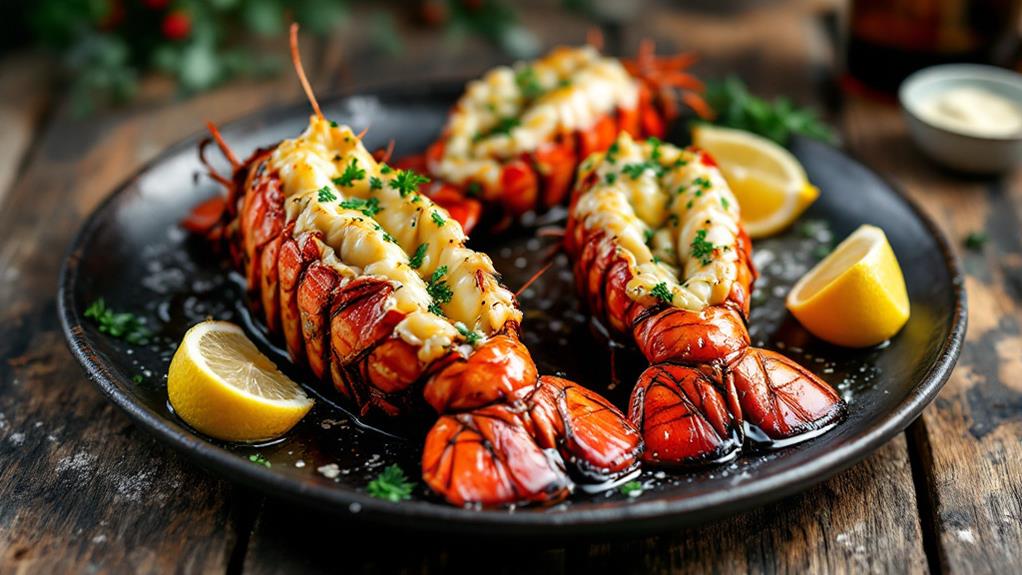When you think about a sumptuous seafood dish, broiled lobster tails often come to mind, but selecting the right ones can make all the difference. You'll want to consider factors like sustainability and quality, which can elevate your dining experience. Once you've chosen the perfect tails, the preparation process reveals various seasoning options that can complement the natural flavors. As you begin to explore the techniques for broiling, you'll discover tips that not only enhance taste but also ensure tenderness. And speaking of taste, have you thought about how to pair it all with the perfect wine?
Key Takeaways
- Choose high-quality, sustainably sourced lobster tails for the best flavor and freshness indicators like firm texture and glossy shell.
- Thaw frozen lobster tails overnight in the refrigerator or under cold water for quick preparation.
- Broil lobster tails at 425°F, adjusting cooking time based on size to ensure perfect doneness without overcooking.
- Baste with butter or marinades every few minutes to enhance flavor and moisture during cooking.
- Serve with citrus wedges, herb sprigs, and melted butter for a gourmet experience.
Choosing the Right Lobster Tails
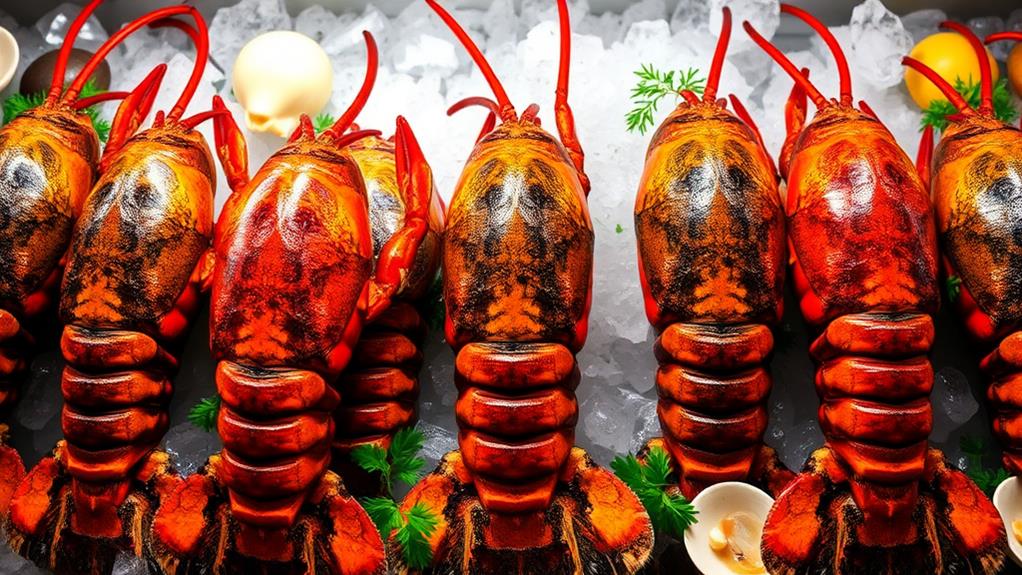
When it comes to choosing the right lobster tails, you want to dive into the details to ensure a delicious meal. First, familiarize yourself with the different lobster tail types. You'll typically encounter Maine lobster, known for its sweet, tender meat, and spiny lobster, which has a firmer texture and a more pronounced flavor. Each type offers a unique culinary experience, so think about what you prefer.
Next, consider sustainable sourcing. It's crucial to choose lobster tails that are harvested responsibly. Look for products certified by organizations like the Marine Stewardship Council (MSC) or the Aquaculture Stewardship Council (ASC). These certifications guarantee that the lobsters come from well-managed fisheries or farms, promoting healthy ecosystems.
When buying lobster tails, inspect them closely. Fresh tails should be firm, with a glossy shell and a mild ocean scent. Avoid any that appear discolored or have a strong, fishy odor.
Essential Cooking Tools
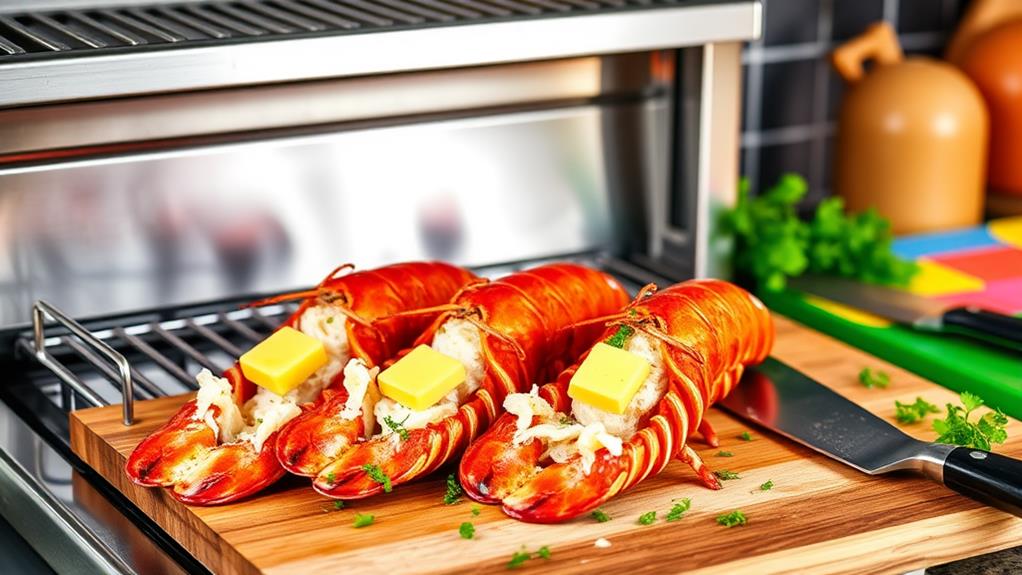
After selecting the perfect lobster tails, it's time to gather the right tools to elevate your cooking experience. Having the right lobster tail essentials and broiling equipment can make all the difference in achieving that mouthwatering flavor and tender texture you crave.
Here's a quick list of must-have tools:
- Sharp Kitchen Scissors: Ideal for cutting through the shell easily without damaging the meat.
- Baking Sheet: A sturdy surface for broiling your lobster tails, ensuring even cooking.
- Broiler Pan: This allows fat to drip away while providing even heat from above.
- Basting Brush: Perfect for applying butter or marinades, enhancing flavor and moisture.
- Meat Thermometer: To check for doneness, ensuring your lobster tails are cooked perfectly, avoiding overcooking.
With these lobster tail essentials in hand, you're all set to embark on your culinary adventure.
Each tool plays a vital role in transforming those fresh tails into a delectable dish that'll impress anyone lucky enough to share your table.
Preparing the Lobster Tails
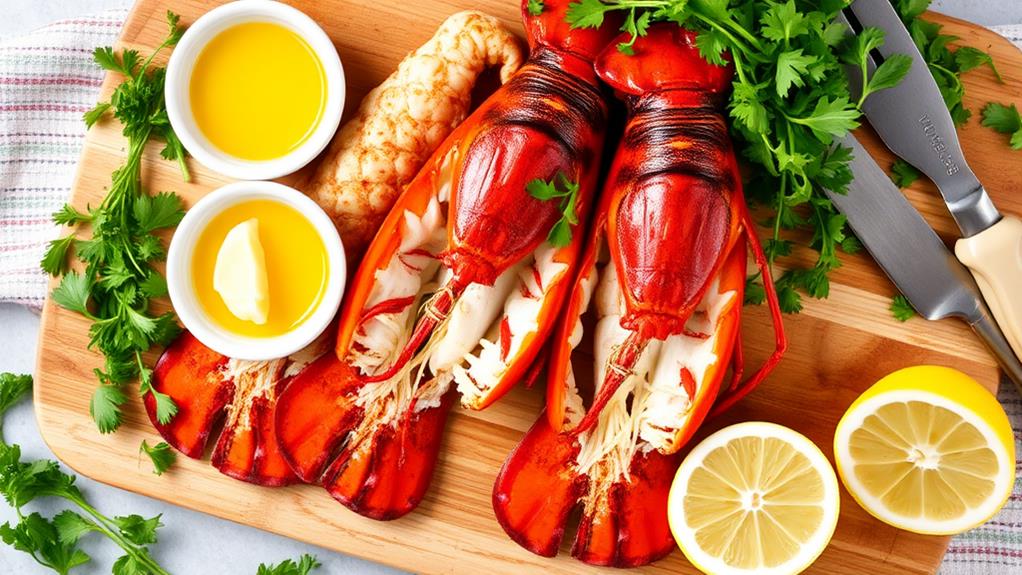
With your tools ready, it's time to dive into preparing the lobster tails for broiling. First, you'll want to choose high-quality lobster tails, ideally ones that are sustainably sourced. Look for tails that are firm and have a slight sheen, as these indicate freshness.
Lobster tail origins matter; many come from the Atlantic or Pacific, but make sure they're harvested responsibly to support sustainability.
Start by thawing frozen lobster tails in the refrigerator overnight or under cold running water for about 30 minutes. Once thawed, place the tails on a cutting board. Using a sharp knife or kitchen shears, carefully cut down the center of the shell, stopping just before the tail fin. This will allow the meat to easily lift out and create a stunning presentation.
Next, gently pull the lobster meat from the shell, keeping it attached at the base. You can then rest it on top of the shell, ready for broiling. This method not only enhances the visual appeal but also allows the meat to absorb more heat and flavor while cooking.
Now that you've prepared the lobster tails, you're set for the next exciting step!
Seasoning Options
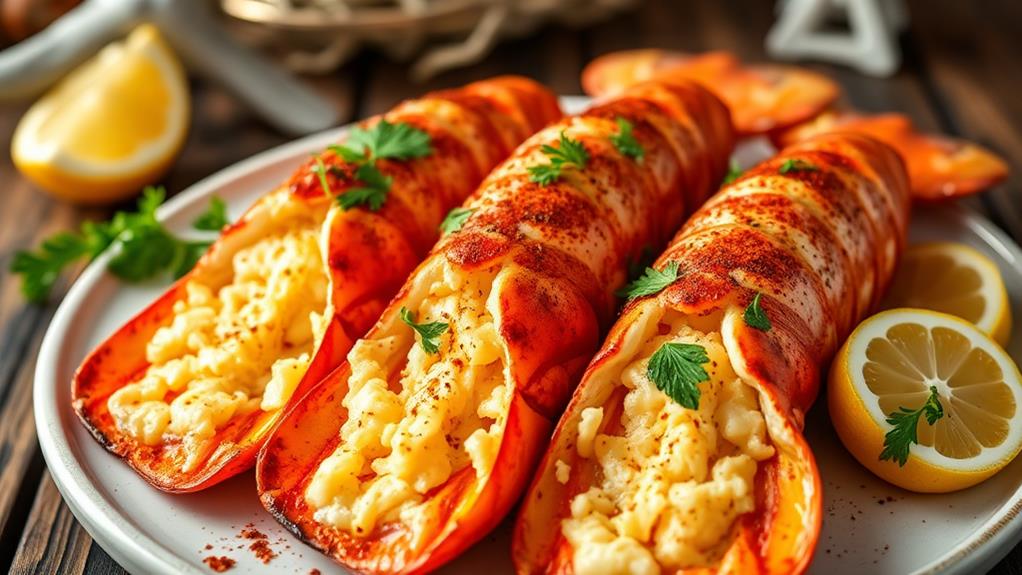
To elevate the flavor of your broiled lobster tails, exploring various seasoning options is essential. The right blend can transform your dish into a memorable experience, tantalizing your taste buds with every bite.
Here are some delicious ideas to consider:
- Spicy Garlic: Infuse your lobster tails with a bold kick by mixing minced garlic, chili flakes, and olive oil.
- Lemon Herb: Combine fresh lemon juice, zesty lemon peel, and chopped herbs like parsley and dill for a refreshing taste.
- Buttery Blend: Melt butter and mix in garlic, lemon juice, and a sprinkle of herbs for a rich, savory marinade.
- Asian Glaze: Create a sweet and savory concoction using soy sauce, honey, ginger, and sesame oil for an unexpected twist.
- Mediterranean Zest: Blend together olive oil, smoky paprika, and oregano for a Mediterranean flair that complements the lobster perfectly.
Don't forget to experiment with a citrus infusion, enhancing your seasoning with fresh lime or orange zest.
With these options, your broiled lobster tails will shine with flavor and delight anyone who takes a bite!
Broiling Techniques
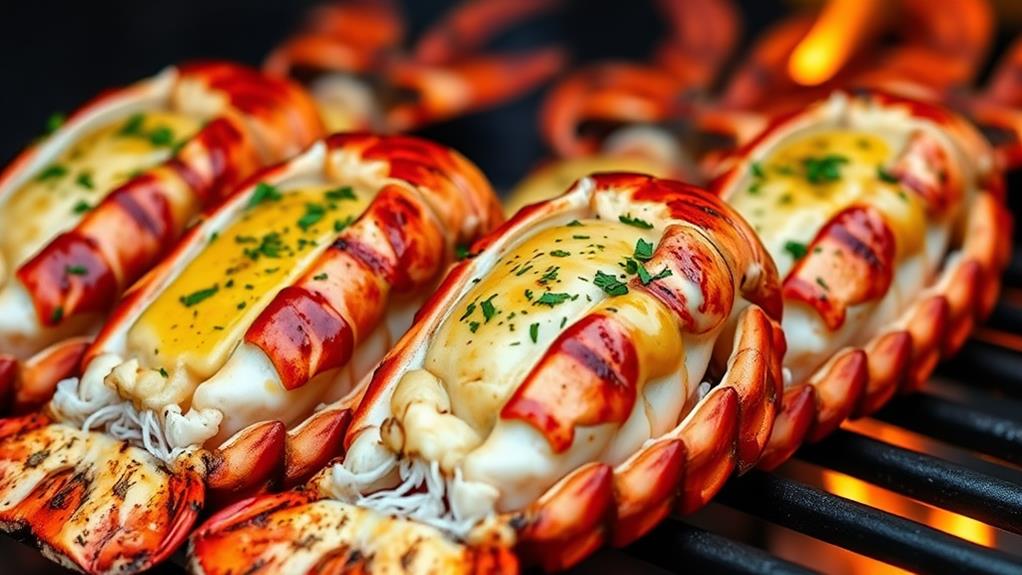
Master the art of broiling lobster tails, and you'll unlock a world of delicious possibilities. Broiling methods can vary, but the goal remains the same: to achieve that perfect balance of tender meat and a slightly crispy top. Start by preheating your broiler for optimal heat distribution.
Here's a quick overview of popular broiling techniques:
| Broiling Method | Description |
|---|---|
| Direct Broil | Place lobster tails under the broiler, 4-6 inches from the heat source. |
| Indirect Broil | Use a two-zone setup, allowing for slower cooking while keeping the tails juicy. |
| Basting Technique | Baste with butter or marinade every few minutes for added flavor and moisture. |
Whichever method you choose, remember to keep a close eye on your lobster broil. The high heat can quickly transform your tails from perfect to overdone. With these techniques in your culinary arsenal, you're well on your way to creating mouthwatering lobster tails that'll impress any guest. Enjoy the journey of broiling, and savor each bite!
Cooking Time Guidelines
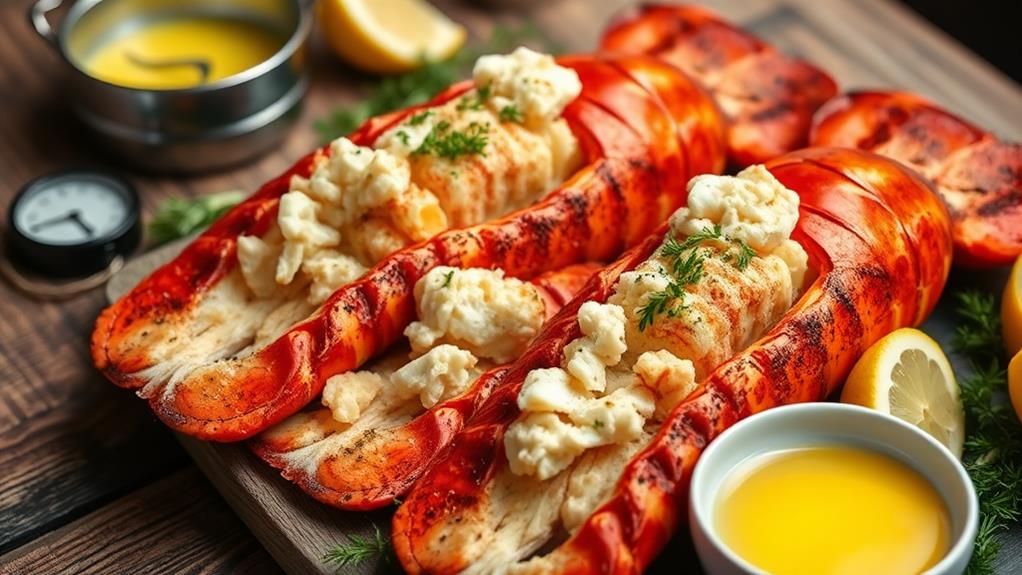
Timing is crucial when broiling lobster tails to ensure they're perfectly cooked and bursting with flavor. Each lobster tail size requires a different cooking time, so it's essential to adjust based on what you're working with.
Here are some cooking time guidelines to keep in mind:
- Small (4-5 ounces): Broil for 5-7 minutes at a cooking temperature of 425°F.
- Medium (6-7 ounces): Broil for 7-9 minutes at 425°F.
- Large (8-10 ounces): Broil for 9-11 minutes at 425°F.
- Extra Large (11-14 ounces): Broil for 11-13 minutes at 425°F.
- Jumbo (15 ounces and up): Broil for 13-15 minutes at 425°F.
Checking Doneness
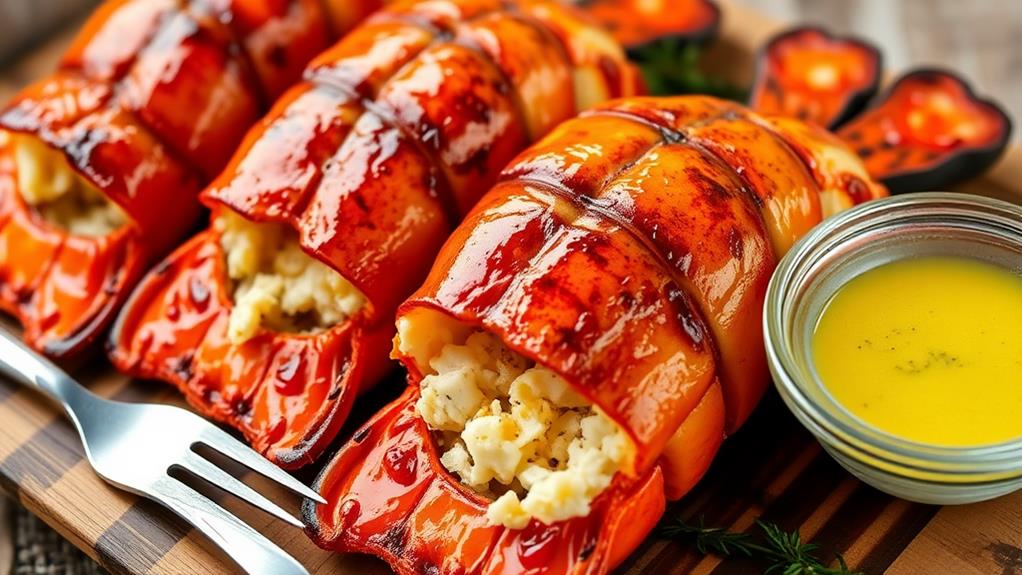
Checking for doneness is essential to ensure your broiled lobster tails are perfectly cooked and ready to impress. As you approach the final moments of cooking, look for key doneness indicators. The flesh should transform from a translucent, glossy appearance to a firm, opaque white. This visual cue is your first signal that the lobster is nearing perfection.
Next, gently touch the meat with a fork or your fingers. If it feels firm but still has a slight give, that's a good sign. Avoid overcooking, as this can lead to rubbery textures. For an extra measure, you can use a meat thermometer—ideal internal temperature for lobster tails is around 145°F.
Another helpful tip is to check the edges of the meat. If they curl slightly and separate from the shell, this is another indicator that your lobster is done.
Serving Suggestions

Once you've nailed the perfect doneness for your broiled lobster tails, it's time to think about how to serve them in style.
The presentation can elevate your dish from delicious to stunning, so don't skip the garnishing tips. Here are some creative presentation ideas to impress your guests:
- Citrus wedges: Arrange fresh lemon or lime wedges around the plate for a pop of color and a zesty touch.
- Herb sprigs: Use parsley or dill as a vibrant garnish, adding freshness to your dish.
- Butter sauce: Serve melted garlic butter in a small dish for dipping, enhancing flavor and adding a rustic charm.
- Sea salt sprinkle: A light dusting of flaky sea salt can elevate the taste and add a gourmet touch.
- Edible flowers: Consider adding a few edible flowers for an elegant and colorful finishing touch.
When plating, place the lobster tails in the center, and let the garnishes frame them beautifully.
Pairing Wines
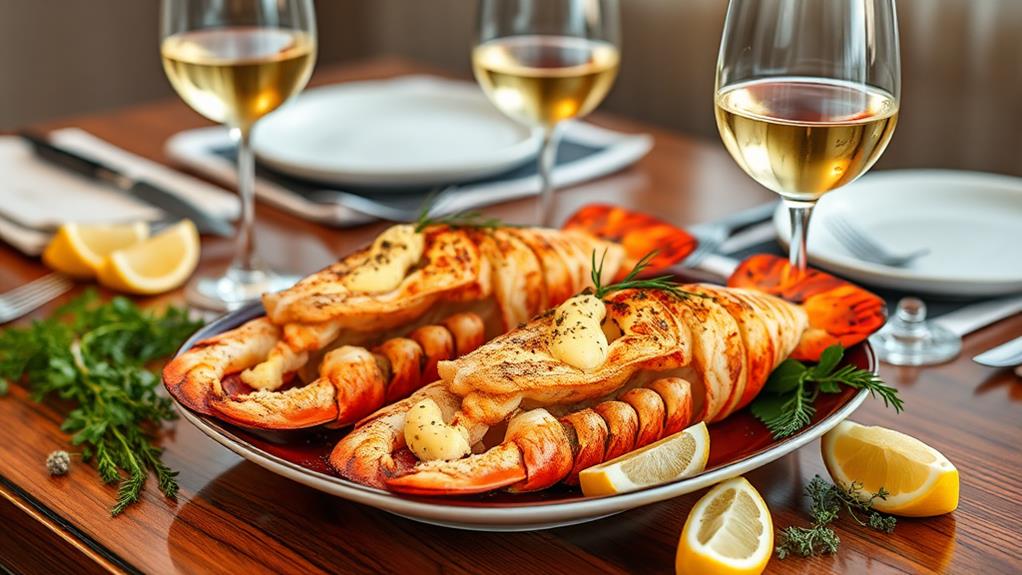
Choosing the right wine can transform a meal into a memorable dining experience, especially when serving broiled lobster tails. The delicate sweetness of the lobster pairs beautifully with wines that enhance its flavor without overpowering it.
A classic choice is a crisp Chardonnay, particularly from cooler wine regions like Sonoma or Burgundy. Its buttery notes and bright acidity complement the richness of the lobster.
If you're looking for something lighter, consider a Sauvignon Blanc. This wine's zesty citrus and herbal flavor profiles accentuate the sweet, briny notes of the seafood.
For a touch of elegance, a sparkling wine, such as Champagne or a local Prosecco, can elevate your meal, adding a delightful effervescence that cleanses the palate.
Don't underestimate the versatility of a light Pinot Grigio, either. Its refreshing character and subtle fruitiness make it a fantastic partner for broiled lobster.
For those who prefer red, a chilled Pinot Noir from Oregon's wine regions can work surprisingly well, offering a fruit-forward profile that won't clash with the dish.
Storing Leftovers

Storing leftovers from your broiled lobster tails is essential to maintaining their delicious flavor and texture for future meals. To ensure your lobster remains fresh and appetizing, follow these simple steps:
- Cool it down: Let the lobster tails cool to room temperature before storing.
- Wrap properly: Use airtight containers or wrap them tightly in plastic wrap to prevent air exposure.
- Label and date: Mark containers with the date to keep track of freshness.
- Freezing lobster: If you won't eat the leftovers within a couple of days, freezing is your best option. Make sure to place them in a freezer-safe container to avoid freezer burn.
- Reheating methods: When you're ready to enjoy your lobster again, consider gentle reheating methods. Steaming or using a microwave on low power helps retain moisture and flavor.
Creative Recipe Variations
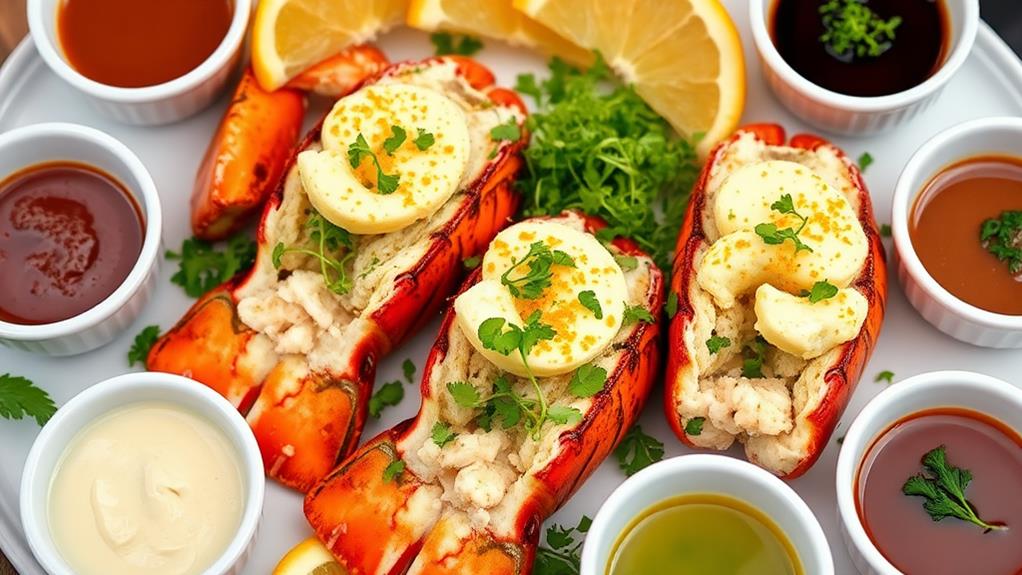
Elevating your broiled lobster tails can be as simple as experimenting with creative recipe variations that enhance their natural flavors. One delicious option is to whip up a gourmet butter blend infused with garlic, lemon zest, and fresh herbs like parsley or dill. This combination not only adds richness but also complements the sweet, tender meat of the lobster.
For a unique flavor combination, consider adding a touch of heat with chili flakes or a splash of sriracha to your butter. The balance of spice against the subtle sweetness of the lobster creates a memorable dish.
Alternatively, try a Mediterranean twist by mixing sun-dried tomatoes, capers, and olives into your butter blend, transporting your taste buds to the coast of Italy.
If you're feeling adventurous, explore Asian-inspired flavors. A blend of soy sauce, ginger, and sesame oil can elevate your lobster tails to gourmet status. Serve with a side of coconut rice for a complete meal.
These creative variations ensure your broiled lobster tails remain exciting and flavorful, making every bite a special experience. Don't hesitate to experiment—your taste buds will thank you!
Frequently Asked Questions
Can I Use Frozen Lobster Tails for Broiling?
Absolutely, you can use frozen lobster tails for broiling. Just ensure you thaw them properly first. Mastering lobster tail preparation and broiling techniques will elevate your dish, making it delicious and impressive for any occasion.
How Do I Tell if Lobster Tails Are Fresh?
Did you know over 60% of seafood consumers can't identify fresh lobster? To check lobster tail freshness, look for firm, shiny shells and a mild ocean smell. Avoid tails with discoloration or a strong, unpleasant odor.
What's the Best Way to Thaw Frozen Lobster Tails?
To thaw frozen lobster tails, you've got a couple of effective thawing techniques. The best method is placing them in the refrigerator overnight for gradual thawing. This ensures optimal texture and flavor for your lobster preparation.
Are There Health Benefits to Eating Lobster?
Eating lobster offers numerous health benefits, packed with nutritional value like protein and omega-3 fatty acids. Compared to seafood alternatives, it's a delicious choice that supports heart health and boosts your immune system effectively.
How Do I Safely Dispose of Lobster Shells?
Like a magician's disappearing act, you can safely dispose of lobster shells through shell recycling programs or composting options. Both methods not only minimize waste but also enrich the soil, turning leftovers into life.
